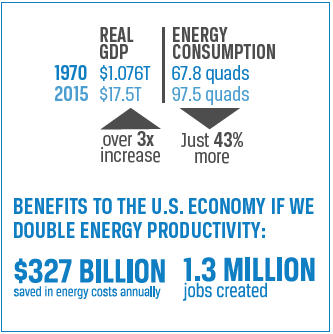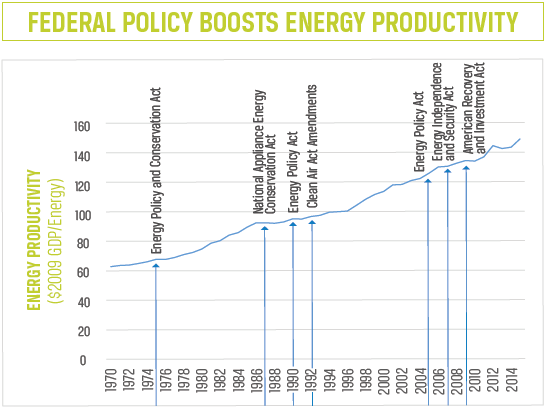Doubling Energy Productivity: Measuring the Benefits of Stewardship in Economic Growth

Doubling Energy Productivity: Measuring the Benefits of Stewardship in Economic Growth
What is Energy Productivity?
Energy productivity tells us how effectively we transform energy use into economic output. It quantifies the economic benefits of efficient energy use by measuring the economic output per unit of energy consumed.
Economic output can be quantified in a variety of ways — e.g., GDP, corporate revenues, or specific goods produced, such as cars or televisions. Energy consumption also can be measured in different ways, including kilowatt hours (kWh) of electricity, barrels of oil equivalent or total primary energy consumption. An increase in energy productivity thus equates to an increase in U.S. competitiveness, energy independence, national security, and a stronger economy.

Isn't This All Just Semantics?
No, and here’s why: Focusing on improving energy productivity provides a common measurement for the value of energy efficiency, and enables decision makers worldwide to evaluate and articulate the benefits that result from implementing energy-efficient technologies and practices. In other words, framing energy efficiency in terms of its ability to improve energy productivity focuses on achieving economic, energy and environmental goals that improve American competitiveness – such as job creation, GDP growth, energy security and emissions reductions.

Federal Policy Boosts Growth in Infrastructure, Manufacturing, and Transportation:
Bipartisan policies implemented under Republicans and Democrats alike, including Gerald Ford, Ronald Reagan, George H.W. Bush, George W. Bush, and Barack Obama, have had profound positive impacts on industries and hardworking Americans.
- Water Infrastructure
Reducing energy consumption at water treatment plants and water conveyance and distribution systems involves improving energy efficiency and demand response, implementing emerging technologies and processes, and deploying energy recovery and generation technologies.
- Smart Manufacturing
Sensors and other information and communications technology (ICT) will allow industries better control over their processes and improved energy management of their buildings.
- Better Transportation
Increasing the energy productivity of moving goods and people relies on developing and deploying new technologies that increase vehicle efficiency and options for mass transit while integration transportation needs with the built environment to reduce demand for motorized transport.

Energy Efficiency is the Least Cost Approach to U.S. Environmental Stewardship:
By prioritizing energy efficiency and by improving U.S. energy productivity, the financial investments required to meet U.S. sustainability goals can be lowered by $2.8 trillion in the transition to a clean energy economy, ultimately improving public health and saving taxpayers’ money.
STAY EMPOWERED
Help the Alliance advocate for policies to use energy more efficiently – supporting job creation, reduced emissions, and lower costs. Contact your member of Congress.
Energy efficiency is smart, nonpartisan, and practical. So are we. Our strength comes from an unparalleled group of Alliance Associates working collaboratively under the Alliance umbrella to pave the way for energy efficiency gains.
The power of efficiency is in your hands. Supporting the Alliance means supporting a vision for using energy more productively to achieve economic growth, a cleaner environment, and greater energy security, affordability, and reliability.



